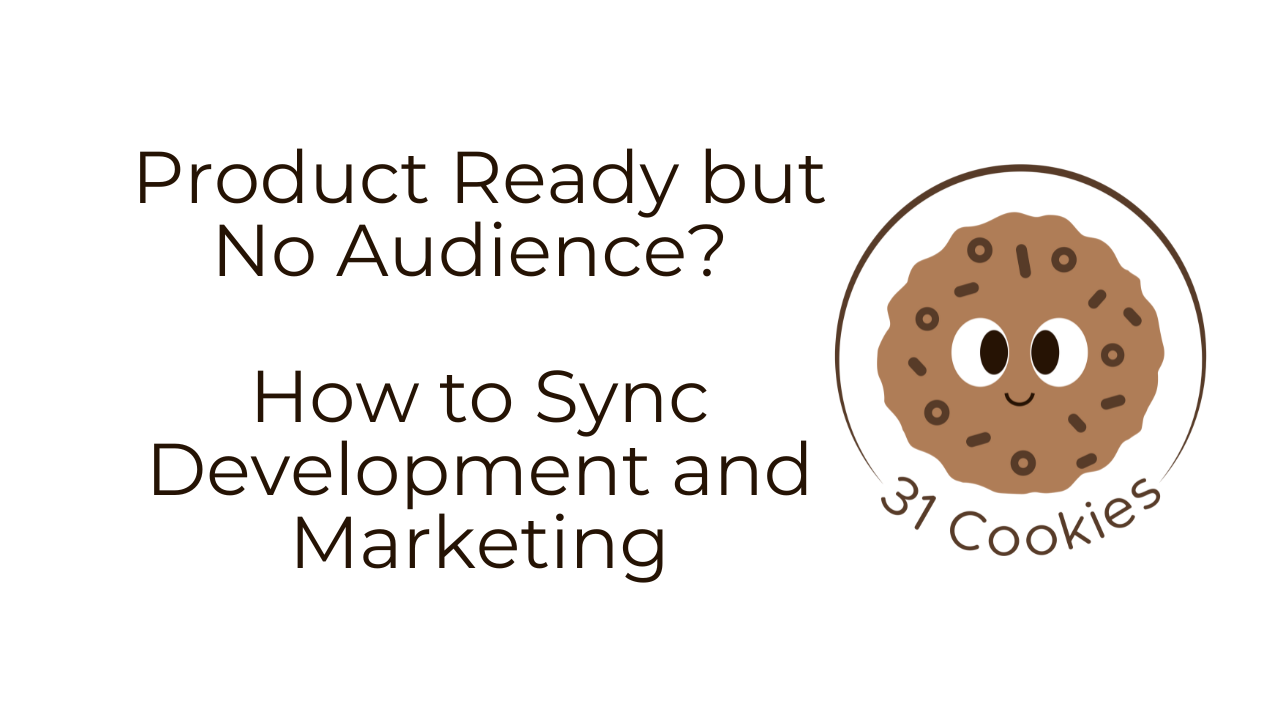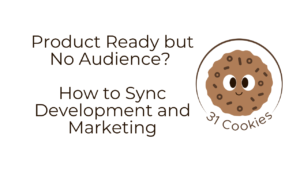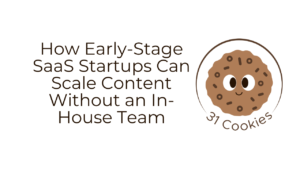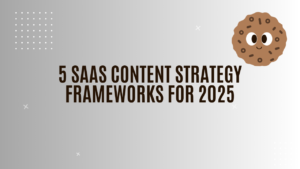SaaS founders have little room for missteps, given their limited funding, evolving competitors, and customers whose expectations increase with every new product they try.
It can push them to focus almost entirely on the build, leaving marketing as an afterthought.
We spoke with two marketers who work at the intersection of product and content to understand the practical steps founders can take to keep both moving in tandem from day one.
You can find frameworks in this piece or opt for a partner like 31 Cookies to avoid creative burnout.
| A quick shoutout to the experts in this piece:💭Navya Donkena, B2B SaaS Product Marketing Manager at VNET India, sits right at the intersection of product management and marketing. Her day includes brainstorming product ideas, building roadmaps, interacting with users, gathering feedback, refining UI/UX flows, and helping prioritize features.💭Jyoti Vashisth, a product marketer in B2B SaaS, works across research, messaging, and strategy, while also leading post-launch adoption. She focuses on connecting product intent with user behavior and ensures the story reflects how it works, why it matters, and why a user should adopt it. |
Why Marketing Feels Like an Afterthought in Most Startups
A gap between product building and marketing can result in two kinds of imbalances:
- Over-prioritized product → features no one hears about
- Over-prioritized marketing → hype for something that isn’t ready, creating churn and trust gaps
Based on my research and conversations with marketers who work in both areas, this drift typically stems from six key factors.
- Confusing Product-Building With Business-Building
It’s common for founders to treat “building the product” as the whole job, pouring cycles into feature development while postponing user acquisition and sales.
The result is a technically strong product with no traction because the business side, such as distribution, partnerships, and lead generation, wasn’t developed in parallel.
Despite all the preparation, teams often find themselves scrambling for customers after launch, playing catch-up with already-lost marketing timelines.
🍪Jyoti Vashisth has a helpful tip that might help:
“One tactic I’ve found useful during heavy build phases is repackaging what already exists. That could mean turning internal product demos into short explainer clips, breaking down features in a “Why we’re building this” post, or sharing early user insights as teaser content. It greatly helps keep the narrative warm and build anticipation or bag feedback without waiting for a launch. I don’t think you always need something new to stay relevant.”
- Premature Abandonment of the Product
Some teams declare a product “failed” too soon, pulling the plug weeks after launch when numbers look flat. They refuse to understand that early sales cycles, SEO, and brand trust can take months to show momentum.
Killing a product before these long-tail effects kick in creates false negatives and wastes potential. When this happens, marketing and product teams never get enough time to learn from the customer interactions and re-adjust strategies.
🍪If you’re in a similar situation, this Reddit conversation can help:
Source: Reddit
- Underestimated Scope
Teams set a roadmap, start building, and only realise deep into the process that the work is more complex or different from what they first thought. By then, marketing plans are already in motion, and every shift in the build dissolves the campaign’s effectiveness.
Navya Donkena recalls:
“We had a roadmap for a product launch, but in the later stages, while creating the PRDs, we realized the product scope was very different from what we’d initially estimated. Turns out, we hadn’t done enough due diligence before jumping into production mode. That cost us about a month.”
🍪Every conversation you have upfront is one fewer fire you’ll be putting out post-launch:
- Kick off with shared insights: Bring marketing, product, and even customer-facing teams into the same room before building begins
- Agree on scope, timelines, and ownership early: Clear upfront decisions create a baseline everyone can commit to
- Late Marketing Involvement
Founders pour all their attention into getting the build right, and by the time marketing is looped in, key product decisions are locked, leaving the story to be reverse-engineered around them.
For example, Jyoti Vashisth shared her experience of a launch that failed, “The messaging was disconnected from real user anxieties, and internally, no one had a clear answer to ‘why now’ or ‘why this matters.’ The result? The chaos did show in numbers. Confusion across users, sales, and even the team itself. It looked like a launch, but to me it didn’t feel like one.”
🍪Pausing is often smarter than pushing ahead if your product and marketing feel out of sync. Treat hesitation as a signal to realign:
- Flag misalignment early: If the product isn’t ready to live up to the promise, say it outright before the launch rolls forward
- Delay with purpose: Use the extra time to tighten messaging, adjust features, or close the gaps between what you’re building and what you’re saying
- Reframe internally: Position a delayed launch as insurance against wasted effort and user confusion
The cost of waiting a few weeks is often far less than the cost of launching something that misses the mark.
- Building Without Validating the Problem
Some founders skip early validation and move straight into development, assuming their idea will resonate with users. Without market conversations, prototypes, or MVP testing, they risk creating a polished product that solves a problem too few people care about or one they won’t pay to fix.
This disconnect surfaces late, when adoption stalls despite solid execution. The longer the gap between idea and validation, the harder (and costlier) it becomes to pivot.
🍪Here’s what Redditors think can be done to resolve this issue:
Source: Reddit
- Overpromising in Messaging
If the first user experience feels underwhelming, no amount of post-launch content will quickly rebuild that trust. Therefore, marketing can create excitement, but it can’t fix the fallout when the reality doesn’t match the promise.
Product message becomes the checkpoint where your potential meets (or does not meet) your audience’s expectations.
🍪You can approach this roadblock in three ways:
- Frame the messaging around the moment of first use
Jyoti Vashisth explains, “Excitement in messaging is important, but it has to hold up once someone actually uses the product. I try to write with that moment in mind — the first click, the first action. If there are limitations, I’d rather frame them clearly than gloss over them.”
🍪Turn user conversations into a copy
Navya Donkena opens up about her approach. “We pull them from user interviews, customer calls, or feedback sessions. Most of our messaging inspiration comes straight from users themselves. I try to talk about the product from their point of view, focusing on the problem it solves rather than just features.”
🍪Hire a marketing agency like 31 Cookies to build content strategy frameworks
When the stakes of a launch are high, guessing at the right words isn’t an option. Agencies like 31 Cookies have the advantage of fresh perspectives, experienced writers, and tested processes to shape messaging that reflects what your product can deliver in real-time.
For example, Priyanka Naomi John, founder and CEO of 31 Cookies, recently shared what being intentional with your marketing can bring you:
| 💡Test your messaging against the product as it exists today, not the product as you hope it will be tomorrow. Credibility builds momentum, but overpromising breaks it. |
Ready-to-Use Frameworks to Keep Product and Marketing in Sync
Here are the bare minimum marketing actions that can help stay visible and relevant:
- The Eisenhower + Time Blocking Combo
Separate urgent from important tasks, then assign fixed time slots so that neither product nor marketing gets sidelined.
Draw a 2×2 grid and sort tasks into four quadrants:
- Urgent + Important → Handle immediately
For example, fixing a payment integration bug or launching a last-minute campaign to counter a competitor’s move.
- Important, Not Urgent → Schedule with clear deadlines
For example, building the feature roadmap or preparing a quarterly content strategy.
- Urgent, not important → Delegate
For example, outsource non-core work (blog writing, ad ops, or design) to agencies like 31 Cookies or bring in fractional experts (CMOs, PMs) when bandwidth is tight.
- Neither → Drop, postpone, or batch
For example, re-designing internal slides that don’t affect output.
This matrix becomes your filter, so both founders and teams spend their time wisely.
Once the quadrants are clear, assign time blocks or pair your priorities with quarterly goals to reduce “context switching” between product and marketing.
For example, a Q1 goal might be “Launch MVP with three core features,” while Q2 focuses on “Expand customer acquisition channels.” This helps teams avoid getting stuck.
You can also have a weekly setup:
- Mornings (deep work): Product sprint work, feature testing, or long-form content creation
- Afternoons (collaborative): Marketing reviews, user feedback syncs, cross-team standups
Use tools like ClickUp to schedule recurring blocks, track progress, and keep both functions moving forward without competing for the same time slots.
| 🍪Jyoti Vashisth and Navya Donkena follow the RICE (Reach, Impact, Confidence, Effort) model to some extent for prioritization, evaluating where to go deep versus where to keep it lean. |
- Consult This Checklist
Here’s a compact checklist you can copy-paste to streamline your workflow:
Run quick syncs before each sprint or launch to align scope, timelines, and priorities
Start marketing prep while product builds are still in progress to keep momentum
Block mornings for deep work and afternoons for collaboration; use frameworks like Eisenhower or RICE to prioritize
Adjust the budget by stage, prioritize the product early on, then shift spend toward marketing as you scale
Outsource specialist or time-heavy tasks (content, design, ads) to save bandwidth
Create a shared Slack/Teams channel and hold weekly updates to spot risks early
Treat launches as joint events with coordinated timelines, and run teasers/tests if delays happen
Track KPIs side by side (product → adoption, churn; marketing → conversions, ROI) and review quarterly
Share short internal digests of industry trends so both teams stay sharp on shifts and competitor moves
Define a one-line product promise, an anti-persona (who it’s not for), and a proof point (demo, beta quote, or case study) for every launch
| An Example of Product and Marketing Working Together: Navya Donkena worked on a big feature in one of her organizations where product and marketing processes ran in parallel. Here’s how the two teams established an in-sync relationship: “While product focused on the PRD and use case documentation, marketing dug into audience pain points, benefits, and overall positioning.We broke it into stages:Stage 1: Product created documentation and demos for the rest of the teams. Everyone tried the product hands-on and shared feedback from a user perspective. This gave sales and marketing a deeper understanding.Stage 2: Product went into development, marketing worked on messaging frameworks, positioning, and value proposition.Stage 3: Product started testing; marketing validated messaging with customers and test groups, and rolled out teasers.Stage 4: Product launched to existing users and gathered feedback; marketing launched campaigns and tweaked them for performance and adoption.That parallel, stage-based approach made sure we launched with clarity, alignment, and momentum.” |
Turn Your Present Insights into Your Next Steps
As our two experts’ experiences demonstrate, missteps often stem from timing, scope, or treating marketing as an afterthought. You can fix this by building small bridges early: turning demos into content, validating ideas with users, and giving marketing enough room to shape the story alongside the product.
For founders who already feel stretched thin, building those bridges can be a challenge. That’s where partners help. Agencies like 31 Cookies bring proven frameworks, messaging clarity, and execution support to show your target audience why they should care about your product.
Get in touch with 31 Cookies and set your product up for your audience today!







